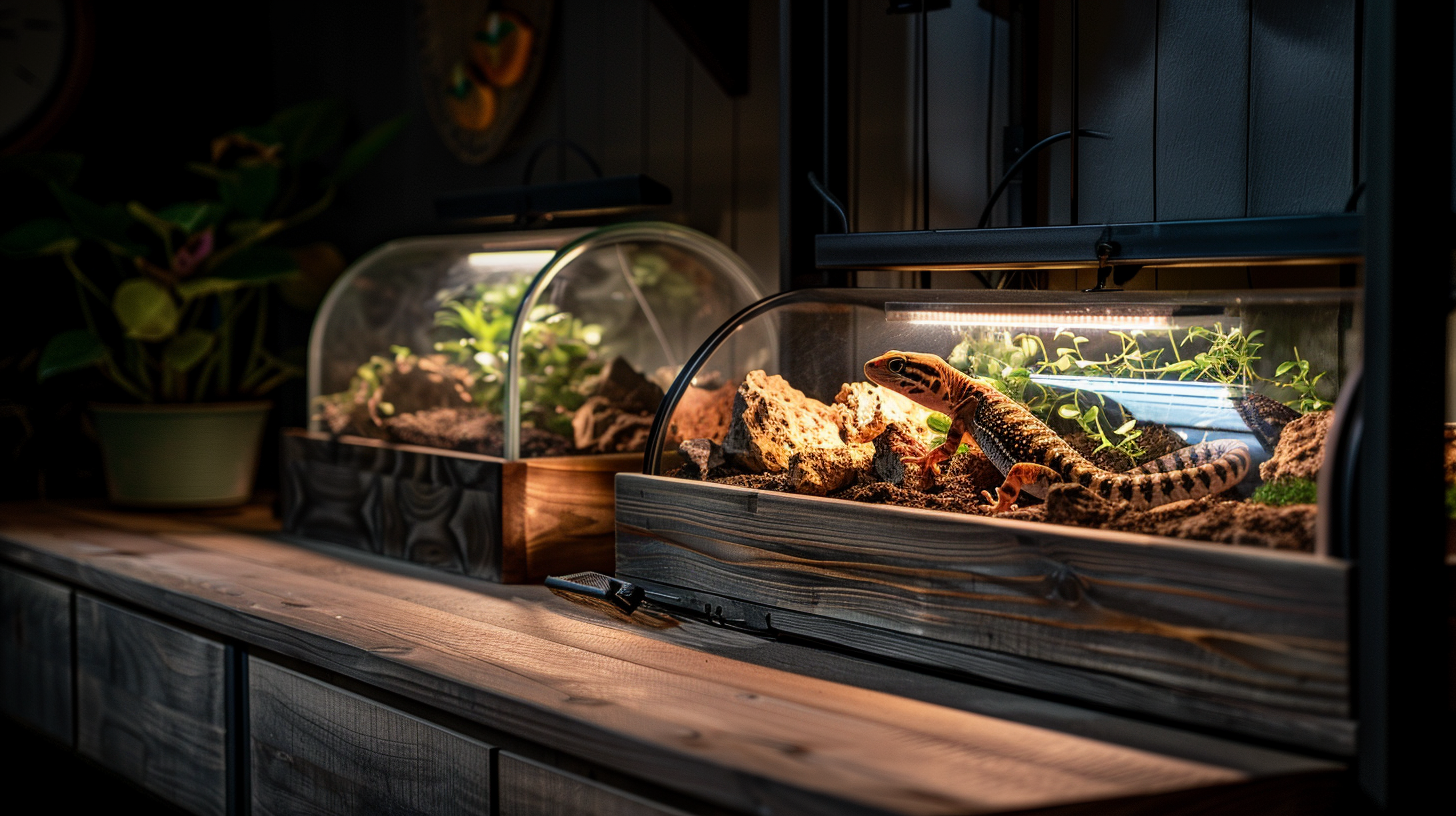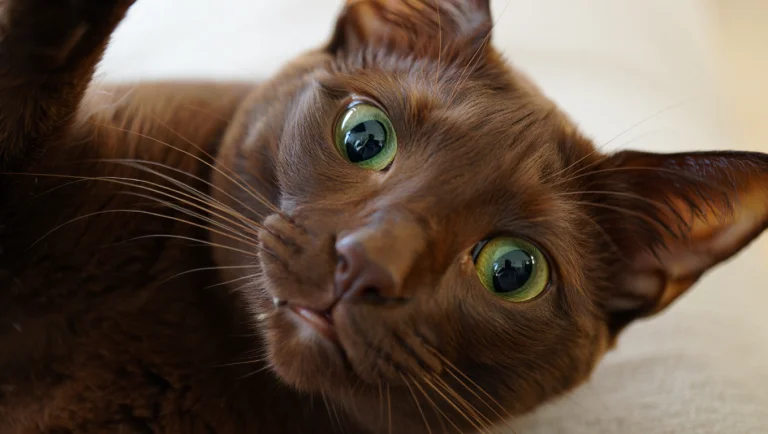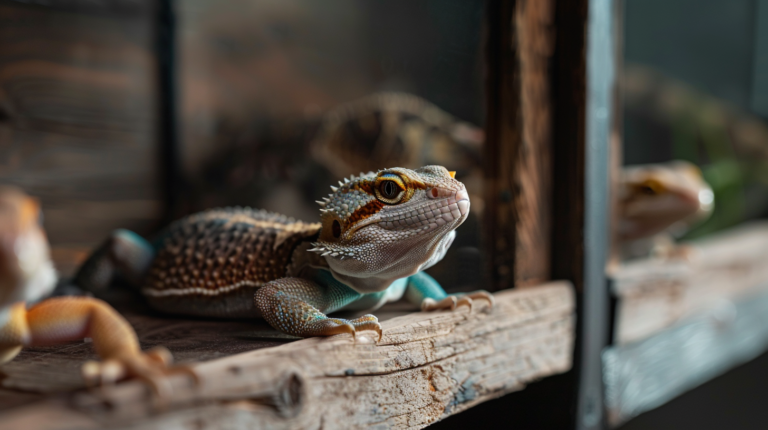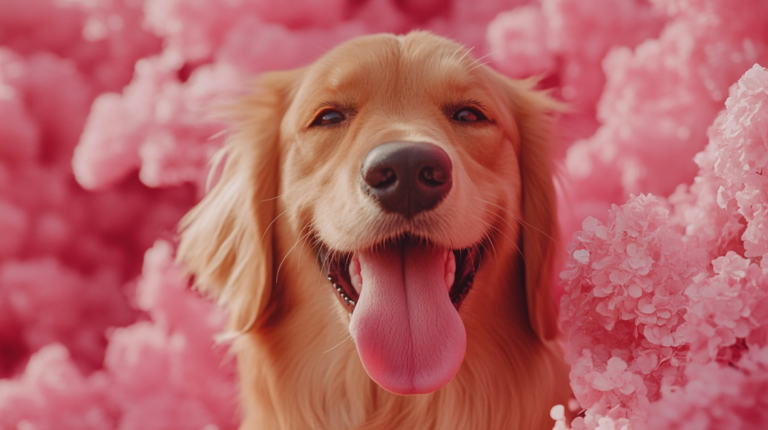Discover the 7 best reptile pets for beginners that are easy to care for and fascinating to watch. Find your perfect scaly companion with our comprehensive guide.
Table of Contents
Considering a pet that’s a little less conventional than a cat or dog? Reptiles make fascinating companions that can fit into many lifestyles where traditional pets might not. The best reptile pets for beginners offer relatively simple care requirements while providing endless entertainment and educational value. Whether you’re limited on space, have allergies to furry animals, or simply want something unique, the world of reptile keeping might be perfect for you.
Reptiles have become increasingly popular pets over the past decade, with an estimated 4.5 million U.S. households owning at least one reptile according to the American Pet Products Association. This growth isn’t surprising—many reptiles require less daily maintenance than mammals, don’t need to be walked, make minimal noise, and some species can live 20+ years with proper care, making them long-term companions.
However, not all reptiles are suitable for novices. Some species require specialized environmental conditions, complex diets, or grow to sizes that demand significant space and resources. That’s why we’ve compiled this comprehensive guide to the best reptile pets for beginners—creatures that are hardy, relatively easy to care for, and still provide all the fascination and joy that makes reptile keeping so rewarding.
Let’s explore seven beginner-friendly reptiles that will introduce you to the wonderful world of herpetology—the study of reptiles and amphibians—without overwhelming you with complex care requirements or unexpected challenges.
1. Leopard Gecko (Eublepharis macularius)
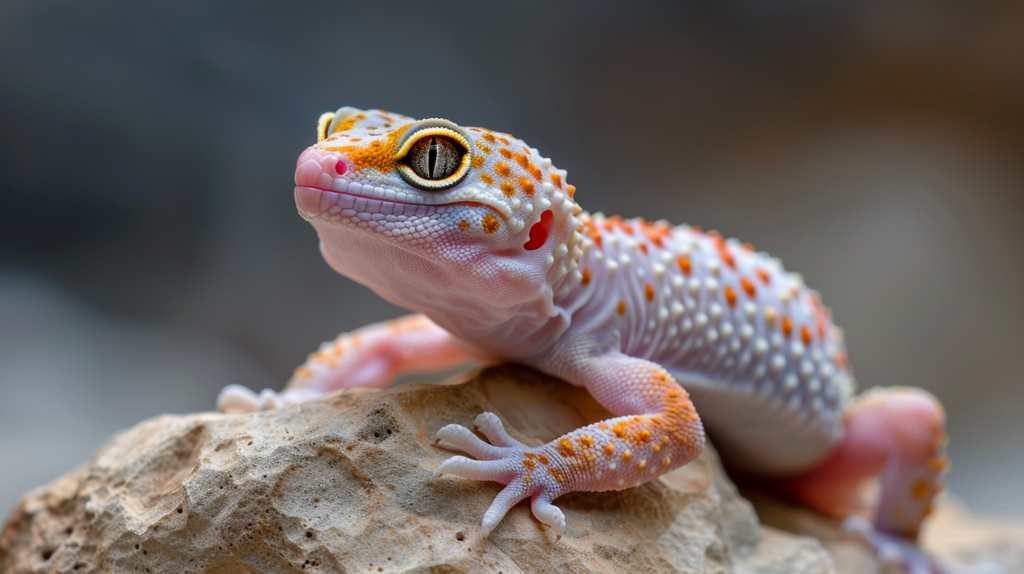
Why They’re Perfect for Beginners
Leopard geckos consistently top the lists of best reptile pets for newcomers, and for good reason. These charming little lizards combine manageable size, simple habitat requirements, and engaging personalities, making them the ideal gateway reptile.
Size and Lifespan
- Adult Size: 8-10 inches (20-25 cm)
- Weight: 45-80 grams
- Lifespan: 10-20 years (with proper care)
Their modest size means leopard geckos don’t require enormous enclosures, making them suitable for keepers with limited space. Their impressive lifespan also means you’re getting a long-term companion that will be with you through many life changes.
Housing Requirements
Setting up a leopard gecko habitat is straightforward:
- Tank Size: A 20-gallon long tank is sufficient for one adult
- Substrate: Paper towels or reptile carpet for beginners; when more experienced, you can transition to a bioactive setup
- Temperature: Maintain a warm side (88-92°F/31-33°C) and cool side (75-80°F/24-27°C)
- Humidity: 30-40% (relatively low, making it easy to maintain)
- Lighting: No special UVB lighting required (one of few reptiles where this is true)
- Hides: Provide at least three—one warm, one cool, and one humid hide
Diet and Feeding
Leopard geckos are insectivores with simple dietary needs:
- Primary Diet: Crickets, mealworms, dubia roaches
- Feeding Frequency: Adults eat 2-3 times per week
- Supplements: Calcium powder (with and without D3) and multivitamin supplements
Dr. Susan Donoghue, a renowned reptile nutritionist, explains, “Leopard geckos are efficient hunters that thrive on a varied insect diet. Their calcium requirements are higher than many other reptiles, making proper supplementation critical to preventing metabolic bone disease.”
Handling and Temperament
These geckos typically have docile temperaments and tolerate gentle handling well after an initial acclimation period. Unlike many lizards, they don’t have sticky toe pads, so they won’t climb walls or hang from your ceiling. Their calm demeanor makes them one of the best reptile pets for children (with adult supervision).
Common Health Issues
While generally hardy, watch for:
- Stuck shed, particularly on toes
- Metabolic bone disease (prevented with proper calcium supplementation)
- Impaction (prevented with appropriate substrate choices)
Cost Considerations
- Initial Setup: $150-250 (tank, heating, hides, etc.)
- Gecko: $30-150+ depending on morph (color/pattern variation)
- Annual Maintenance: $100-200 (food, supplements, substrate changes)
Why We Recommend Them
Leopard geckos combine beginner-friendly care with charming personalities. They’re active during evening hours when many people are home, don’t require exotic specialty foods, and their expressive faces seem to display distinct personalities. Their reasonable space requirements and manageable care routine make them ideal for first-time reptile keepers.
2. Bearded Dragon (Pogona vitticeps)
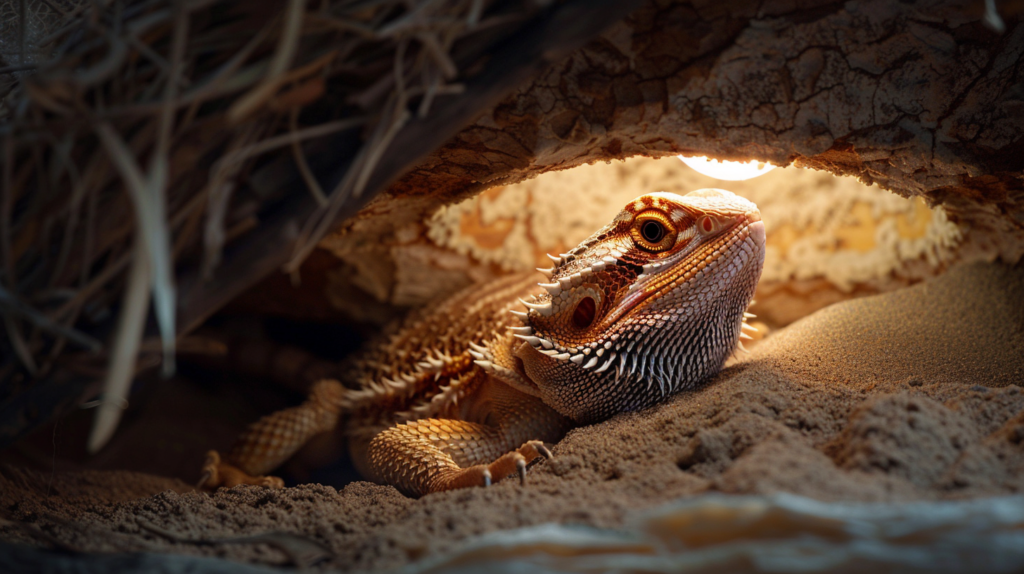
Why They’re Perfect for Beginners
Bearded dragons have become one of the most popular reptile pets worldwide due to their friendly disposition and entertaining behaviors. These “beardies” offer more interaction than many other reptiles, making them especially rewarding for owners who want a more engaged pet experience.
Size and Lifespan
- Adult Size: 16-24 inches (40-60 cm)
- Weight: 300-600 grams
- Lifespan: 8-12 years on average
Bearded dragons are larger than leopard geckos but still manageable for most homes. Their size allows for more visible behaviors and interactions compared to smaller reptiles.
Housing Requirements
While beardies need more space than some other beginner reptiles, their habitat setup follows straightforward principles:
- Tank Size: Minimum 40-gallon breeder tank for juveniles; 75-120 gallons for adults
- Substrate: Paper towels or reptile carpet for beginners; once experienced, you can consider bioactive setups
- Temperature: Basking spot (95-105°F/35-40°C), warm side (85-95°F/29-35°C), cool side (75-85°F/24-29°C)
- Humidity: 30-40% (relatively dry, similar to their native Australian desert habitat)
- Lighting: Require both UVB lighting and heat lamps
- Enrichment: Climbing branches, basking platforms, hide spots
Diet and Feeding
Bearded dragons are omnivores with dietary needs that evolve as they age:
- Juvenile Diet: 80% insects, 20% vegetables
- Adult Diet: 20% insects, 80% vegetables
- Common Food Items: Crickets, dubia roaches, collard greens, mustard greens, squash, bell peppers
- Feeding Frequency: Daily for juveniles, every other day for adults
Herpetologist Dr. Mark Mitchell notes, “The shift in bearded dragon diet from primarily insects to primarily vegetation mirrors their natural development and helps prevent obesity and related health issues in captive specimens.”
Handling and Temperament
Bearded dragons earn their place among the best reptile pets with their social nature:
- Most become accustomed to handling quickly
- Many recognize their owners and may even come to the front of their enclosure when you approach
- They show distinctive behaviors like arm waving, head bobbing, and beard displaying
- Generally tolerate gentle petting and handling sessions of 15-30 minutes
Common Health Issues
Watch for:
- Metabolic bone disease (prevented with proper UVB lighting and calcium)
- Impaction (especially with improper substrates)
- Respiratory infections (from incorrect temperature/humidity)
- Parasites (preventable with good hygiene and regular vet checks)
Cost Considerations
- Initial Setup: $300-500 (larger tank, UVB lighting, fixtures, decor)
- Bearded Dragon: $50-300+ depending on morph
- Annual Maintenance: $300-600 (higher electricity costs, varied diet, larger habitat supplies)
Why We Recommend Them
Bearded dragons offer the perfect balance of manageable care and engaging interaction. Their expressive behaviors, friendly temperament, and distinctive appearance make them incredibly rewarding pets. While they require more space and slightly more complex care than leopard geckos, they reward owners with more visible activity and interaction, earning their place among the best reptile pets for enthusiastic beginners.
3. Corn Snake (Pantherophis guttatus)
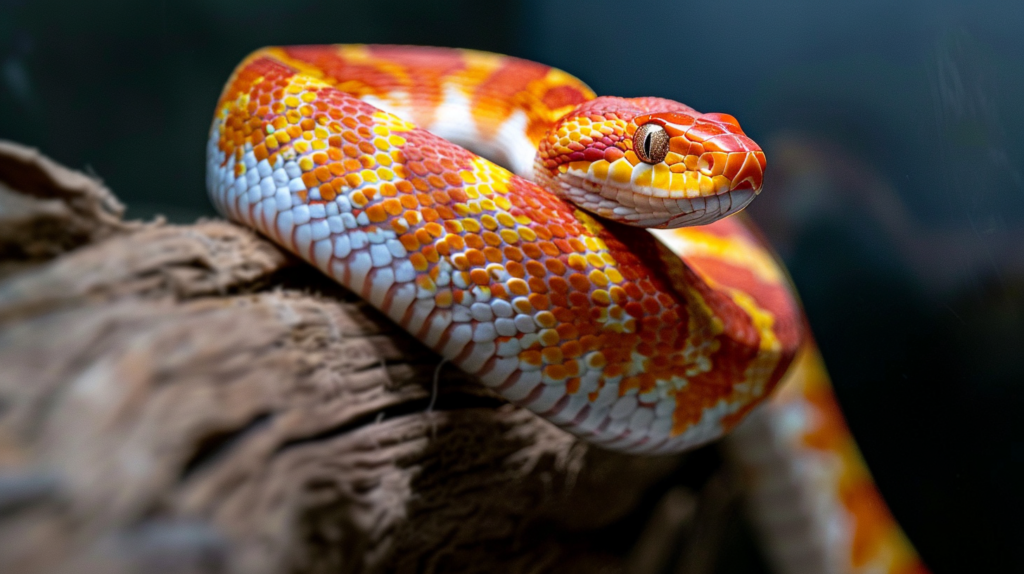
Why They’re Perfect for Beginners
Corn snakes stand out as perhaps the most beginner-friendly snake species available. These colorful North American constrictors combine hardiness, manageable size, and docile temperaments—perfect for novice snake keepers who might be intimidated by other species.
Size and Lifespan
- Adult Size: 3-5 feet (90-150 cm)
- Weight: 300-900 grams
- Lifespan: 15-20+ years
Their moderate size means corn snakes require reasonable enclosures without demanding the space needed for larger snake species like boas or pythons.
Housing Requirements
Corn snake habitats are relatively simple to set up and maintain:
- Tank Size: 20-gallon long for juveniles; 40+ gallons for adults
- Substrate: Aspen shavings, cypress mulch, or paper towels
- Temperature: Warm side (85°F/29°C), cool side (75°F/24°C)
- Humidity: 40-50% (moderate and easy to maintain)
- Lighting: No special lighting required; just ambient room light for day/night cycle
- Hides: At least two secure hiding spots (one on warm side, one on cool side)
Diet and Feeding
Corn snakes have straightforward feeding requirements:
- Diet: Mice appropriate to the snake’s size (pinky mice for hatchlings, adult mice for adult snakes)
- Feeding Frequency: Every 5-7 days for juveniles; every 7-10 days for adults
- Method: Pre-killed prey is safer and recommended (no risk of the prey injuring your snake)
Snake specialist Dr. Kevin Fitzgerald observes, “Corn snakes have excellent feeding responses and rarely refuse meals, making them ideal for beginners who might worry about feeding issues common with more finicky species.”
Handling and Temperament
Corn snakes generally have excellent temperaments:
- Rarely bite when properly socialized
- Become accustomed to handling quickly
- Don’t require daily handling but benefit from regular gentle interaction
- Move at a manageable pace during handling (unlike some faster species)
- Show minimal defensive behaviors compared to other snakes
Common Health Issues
While hardy, be aware of:
- Respiratory infections (from inappropriate humidity/temperature)
- Mites (preventable with proper quarantine of new animals and supplies)
- Mouth rot (prevented with proper humidity and clean environment)
- Stuck shed (usually due to humidity issues)
Cost Considerations
- Initial Setup: $150-300 (tank, heating, hides, thermostat)
- Corn Snake: $30-300+ (price varies dramatically based on morph)
- Annual Maintenance: $100-200 (primarily feeding costs and occasional substrate replacement)
Why We Recommend Them
Corn snakes rank among the best reptile pets for beginners due to their forgiving nature. They tolerate minor husbandry mistakes better than many reptiles, eat readily, and have calm temperaments that help new owners build confidence. Available in dozens of stunning color morphs from bright orange “classic” corns to lavender, albino, and patterned varieties, they offer visual appeal alongside their practical benefits as starter reptiles.
4. Crested Gecko (Correlophus ciliatus)
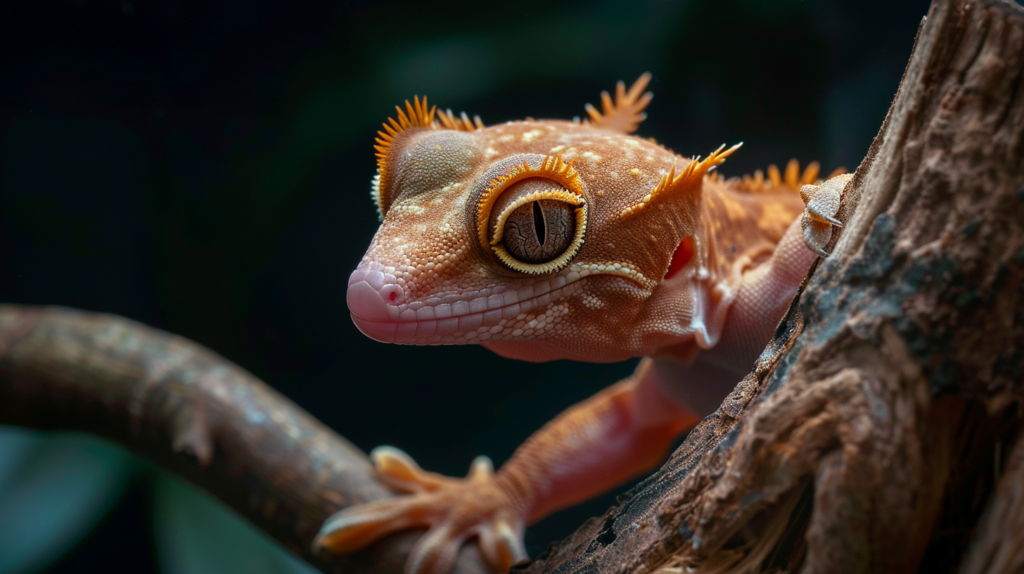
Why They’re Perfect for Beginners
Crested geckos have surged in popularity since their rediscovery in 1994 (they were previously thought extinct). These arboreal geckos from New Caledonia offer unique features that make them exceptional first-time reptiles.
Size and Lifespan
- Adult Size: 6-8 inches (15-20 cm) including tail
- Weight: 25-55 grams
- Lifespan: 15-20 years
Their small size makes them ideal for keepers with space limitations, while their substantial lifespan provides a long-term companion.
Housing Requirements
Crested geckos require vertically-oriented habitats that differ from those of ground-dwelling species:
- Tank Size: 12″x12″x18″ for juveniles; 18″x18″x24″ for adults (tall rather than long)
- Substrate: Paper towels for beginners; coconut fiber or bioactive setup when more experienced
- Temperature: 72-78°F (22-26°C) – one of few reptiles that don’t require additional heating in most homes
- Humidity: 60-80% (spray once or twice daily)
- Lighting: No special UVB required, though some keepers provide low levels
- Habitat Features: Climbing branches, foliage, hiding spots
Diet and Feeding
Crested geckos have perhaps the simplest diet of any reptile on this list:
- Primary Diet: Commercial crested gecko diet (CGD) – a powder mixed with water
- Supplemental Foods: Occasional insects like crickets or small dubia roaches
- Feeding Frequency: Fresh CGD provided every other day
- Vitamins: Not typically needed as commercial diets are nutritionally complete
Reptile nutritionist Allen Repashy, who developed the first commercial crested gecko diet, states, “The development of complete powdered diets revolutionized crested gecko keeping, eliminating the complex dietary balancing previously required for insectivorous reptiles.”
Handling and Temperament
Crested geckos typically display:
- Calm temperaments suitable for gentle handling
- “Jumpy” behavior when startled (careful handling recommended)
- Interesting climbing abilities using specialized toe pads
- Nocturnal activity patterns, becoming most active in evenings
- Distinctive defensive displays including raising their crests and opening their mouths
Common Health Issues
Watch for:
- Dropped tails (unlike many geckos, they don’t regenerate tails once lost)
- Stuck shed, particularly on toes and crests
- Calcium deficiency (rare with proper diet)
- Egg binding in females (can be avoided by maintaining proper weight and conditions)
Cost Considerations
- Initial Setup: $150-250 (vertical terrarium, plants, branches, misting bottle)
- Crested Gecko: $50-300+ depending on color and pattern
- Annual Maintenance: $100-150 (primarily food costs, very economical compared to insect-dependent species)
Why We Recommend Them
Crested geckos earn their place among the best reptile pets for beginners thanks to their room-temperature comfort range, simple powdered diet, and entertaining behaviors. They’re also one of the few reptiles that don’t require insects as a primary food source, making them ideal for those squeamish about handling live bugs. Their specialized toe pads allow them to climb glass and other smooth surfaces, providing endlessly fascinating displays of their natural behaviors.
5. Ball Python (Python regius)
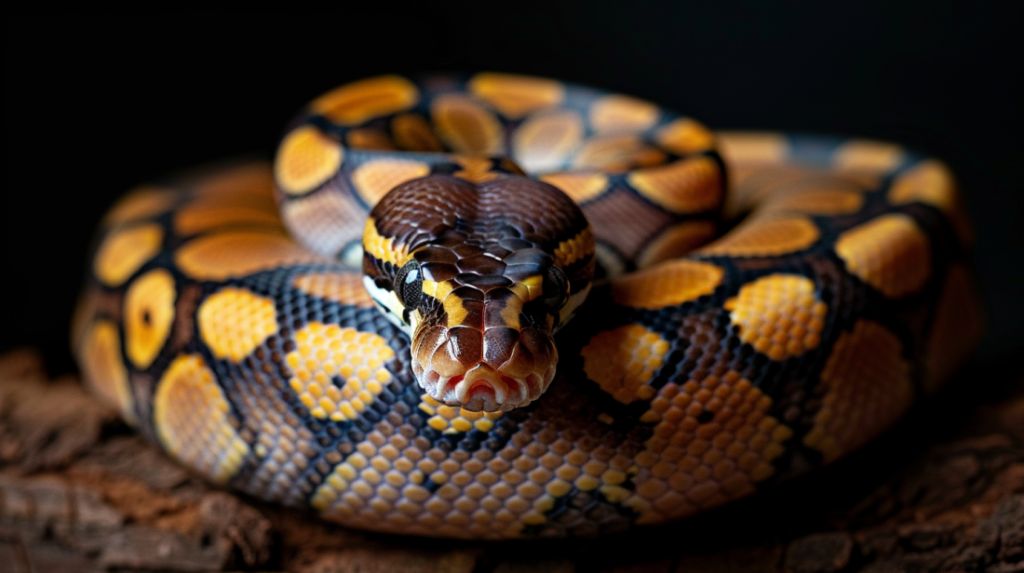
Why They’re Perfect for Beginners
Ball pythons have earned the nickname “the gentle giants” of the pet snake world. These West African constrictors combine impressive size with remarkably docile temperaments, making them approachable even for those new to snake keeping.
Size and Lifespan
- Adult Size: 3-5 feet (90-150 cm), with females typically larger than males
- Weight: 1500-2500 grams for adult females; 800-1500 grams for adult males
- Lifespan: 20-30+ years
Their substantial lifespan means adopting a ball python is a significant long-term commitment—something potential owners should carefully consider.
Housing Requirements
Ball pythons need secure, appropriately-sized enclosures:
- Tank Size: 40-gallon breeder minimum for adults (many keepers prefer larger PVC enclosures)
- Substrate: Cypress mulch, coconut fiber, or paper towels
- Temperature: Basking spot (88-92°F/31-33°C), ambient temperature (78-80°F/25-27°C)
- Humidity: 50-60% (higher during shedding)
- Lighting: No special lighting required; maintain normal day/night cycle
- Hides: At least two secure hides that fit snugly around the snake
Diet and Feeding
Ball pythons are straightforward feeders once established:
- Diet: Appropriately sized rats (mice for hatchlings, rat pups for juveniles, small/medium rats for adults)
- Feeding Frequency: Every 7-10 days for juveniles; every 10-14 days for adults
- Method: Pre-killed prey recommended
- Feeding Issues: Some individuals may go through fasting periods, especially during breeding season
Herpetologist Dr. Adam Britton notes, “Ball pythons earned their name from their defensive behavior of coiling into a tight ball with their head protected in the center. This same docile nature makes them ideal pets, but also means they may refuse food when stressed, requiring patience from their keepers.”
Handling and Temperament
Ball pythons are known for their excellent temperament:
- Rarely bite, even when stressed
- Move slowly and deliberately during handling
- Tolerate regular handling well after acclimation
- Often become very tame with consistent, gentle interaction
- Many will contentedly drape around their handler’s shoulders or arms
Common Health Issues
Be aware of:
- Respiratory infections (often from inadequate temperatures or excessive humidity)
- Mites (preventable with proper quarantine procedures)
- Inclusion body disease (IBD) – a serious viral condition preventable through quarantine
- Regurgitation (usually from handling too soon after feeding)
Cost Considerations
- Initial Setup: $200-400 (enclosure, heating, thermostat, hides)
- Ball Python: $50-thousands depending on morph (common morphs start around $50-100)
- Annual Maintenance: $150-300 (feeding, substrate, electricity for heating)
Why We Recommend Them
Ball pythons make excellent pets for beginners willing to commit to their long lifespan. Their calm temperament, manageable size, and reluctance to bite put them among the best reptile pets for those interested in larger snake species. Available in hundreds of color and pattern variations called “morphs,” ball pythons offer something for everyone—from natural-looking specimens to dramatic designer patterns with price tags to match.
6. Blue-Tongued Skink (Tiliqua species)
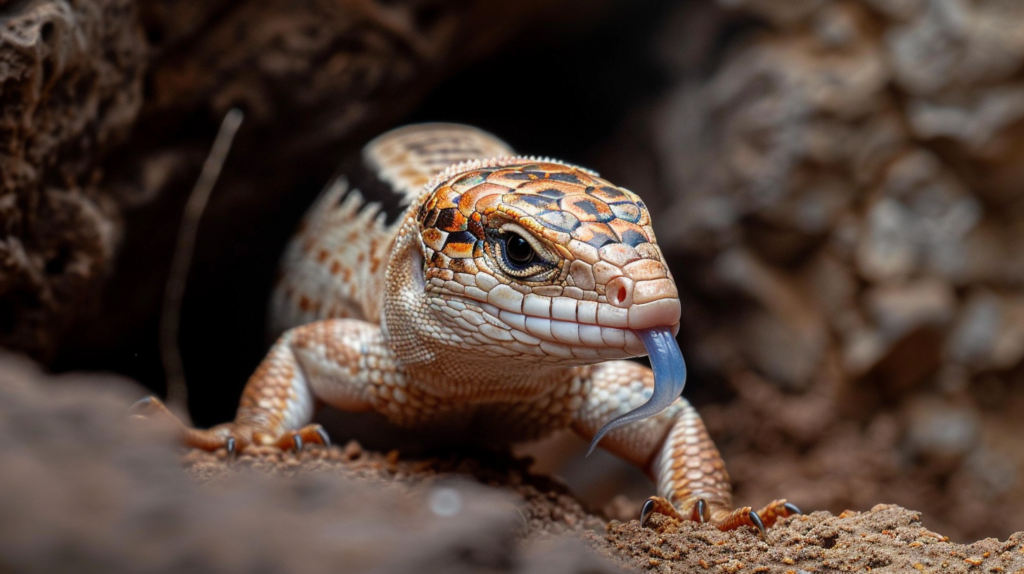
Why They’re Perfect for Beginners
Blue-tongued skinks combine the best features of many reptile pets: the interactive nature of bearded dragons, the hardiness of leopard geckos, and a unique appearance all their own. These large lizards from Australia and Indonesia make excellent starter reptiles for those who want something a bit different.
Size and Lifespan
- Adult Size: 18-24 inches (45-60 cm)
- Weight: 500-800 grams
- Lifespan: 15-20+ years
Their substantial size means they’re easily visible and handleable, while their long lifespan provides decades of companionship.
Housing Requirements
Blue-tongued skinks need spacious ground-level enclosures:
- Tank Size: 40-gallon breeder minimum; 75+ gallons ideal for adults
- Substrate: Cypress mulch, orchid bark, or paper towels (4-6 inches deep for burrowing)
- Temperature: Basking spot (95-100°F/35-38°C), ambient temperature (75-85°F/24-29°C)
- Humidity: 40-60% depending on species (Indonesian species require higher humidity)
- Lighting: UVB lighting recommended
- Habitat Features: Multiple hides, sturdy water dish, flat basking surfaces
Diet and Feeding
Blue-tongued skinks are true omnivores with varied dietary needs:
- Diet: Mix of high-quality dog/cat food, vegetables, fruits, and occasional insects
- Recommended Mix: 50% protein, 40% vegetables, 10% fruits
- Feeding Frequency: Adults eat 2-3 times per week
- Supplements: Calcium and multivitamin supplements
Reptile veterinarian Dr. Susan Horton explains, “Blue-tongued skinks have perhaps the most varied diet of common pet reptiles, allowing them to thrive on readily available foods rather than specialized prey items. This dietary flexibility is part of what makes them such adaptable pets.”
Handling and Temperament
These skinks are known for their excellent temperaments:
- Generally docile and rarely bite
- Become quite tame with regular handling
- Many enjoy exploring outside their enclosures under supervision
- Show recognition of their caretakers
- Display interesting behaviors like tongue-flicking and foraging
Common Health Issues
Watch for:
- Obesity (common with overfeeding)
- Metabolic bone disease (prevented with proper UVB and calcium)
- Respiratory infections (from improper temperature gradients)
- Skin infections (from excessive humidity or dirty substrate)
Cost Considerations
- Initial Setup: $300-500 (large enclosure, UVB lighting, heating elements)
- Blue-Tongued Skink: $150-500+ depending on species and source
- Annual Maintenance: $200-400 (food, substrate, electricity)
Why We Recommend Them
Blue-tongued skinks rank among the best reptile pets for beginners looking for an engaging, visible lizard with straightforward care requirements. Their omnivorous diet means you can feed them many foods already found in your kitchen, and their robust nature makes them forgiving of minor husbandry mistakes. Their distinctive appearance—stout body, short legs, and trademark blue tongue—makes them conversation pieces as well as wonderful companions.
7. Russian Tortoise (Testudo horsfieldii)
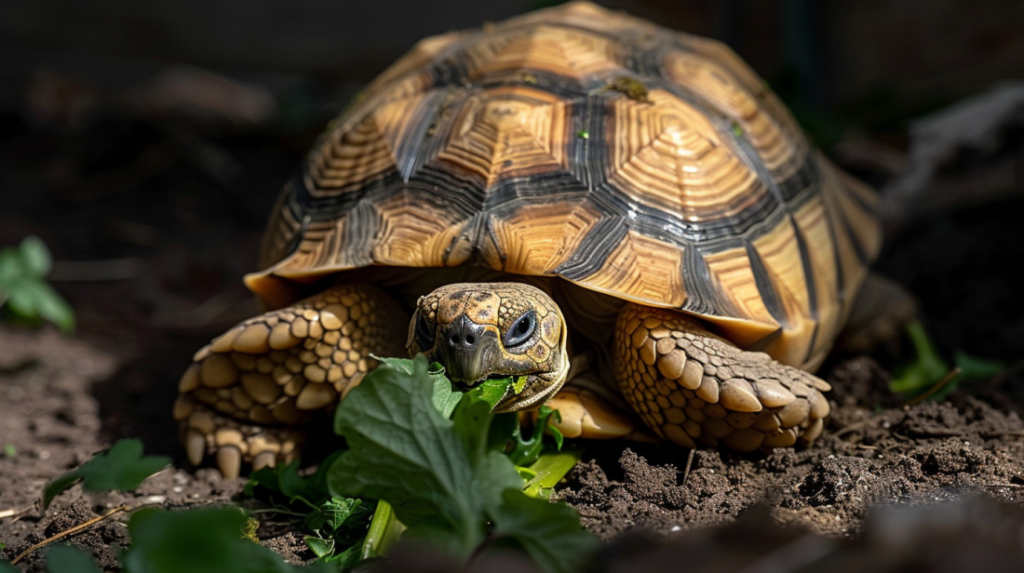
Why They’re Perfect for Beginners
Russian tortoises offer the unique opportunity to care for a chelonian (turtle/tortoise) without the extreme space requirements or lifespan of larger tortoise species. These small but hardy reptiles from Central Asia provide a glimpse into tortoise keeping without overwhelming new owners.
Size and Lifespan
- Adult Size: 6-8 inches (15-20 cm) shell length
- Weight: 0.5-2 pounds (0.2-0.9 kg)
- Lifespan: 40+ years (potentially up to 75+ years with excellent care)
Their impressive longevity means these tortoises often become multi-generational pets, something prospective owners should consider carefully.
Housing Requirements
Russian tortoises need secure enclosures with plenty of space to explore:
- Enclosure Size: Minimum 4′ x 2′ indoor enclosure; larger outdoor enclosures when weather permits
- Substrate: Coconut coir, topsoil/sand mix, or cypress mulch (6+ inches deep for burrowing)
- Temperature: Basking spot (95-100°F/35-38°C), ambient temperature (70-80°F/21-27°C)
- Humidity: 40-50% (generally low, mimicking their arid native habitat)
- Lighting: High-output UVB lighting essential for indoor keeping
- Habitat Features: Multiple hiding spots, sturdy food dish, shallow water dish, climbing features
Diet and Feeding
Russian tortoises have specific dietary needs as herbivores:
- Diet: High-fiber, low-protein plant matter
- Ideal Foods: Dark leafy greens (dandelion, mustard, collard), grasses, hay
- Foods to Limit: Fruits, high-oxalate greens (spinach, chard)
- Feeding Frequency: Daily for juveniles; 3-5 times weekly for adults
- Supplements: Calcium supplement without phosphorus 3-5 times weekly
Tortoise specialist Dr. Barbara Tefft explains, “The key to Russian tortoise health is maintaining a high-fiber, low-protein diet that mimics their natural forage. Overly rich diets lead to shell deformities and kidney issues in these naturally desert-adapted species.”
Handling and Temperament
Russian tortoises typically show:
- Bold, curious personalities
- Tolerance for gentle handling (though they prefer exploring to being held)
- Recognition of caretakers, especially associated with food
- Diurnal activity patterns, most active during daylight hours
- Burrowing behaviors, especially in cooler weather
Common Health Issues
Be vigilant about:
- Shell rot (from excessive humidity or unsanitary conditions)
- Respiratory infections (from cold temperatures or drafts)
- Metabolic bone disease (from insufficient UVB light or calcium)
- Eye infections (often from vitamin A deficiency)
- Pyramiding (abnormal shell growth from improper diet/humidity)
Cost Considerations
- Initial Setup: $300-600 (enclosure, UVB lighting, heating elements)
- Russian Tortoise: $150-300
- Annual Maintenance: $200-400 (primarily food, substrate, electricity, and annual check-ups)
Why We Recommend Them
Russian tortoises earn their place among the best reptile pets for beginners due to their hardiness, manageable size, and engaging behaviors. They’re more active and interactive than many people expect from tortoises, often approaching their keepers and showing distinct personalities. While their multi-decade lifespan requires commitment, it also means forming a bond with a pet that may outlive many others. For those prepared for the commitment, Russian tortoises offer a rewarding introduction to chelonian care.
Essential Equipment for Beginner Reptile Keepers
No matter which of these best reptile pets you choose, certain equipment is essential for proper care:
Temperature Control
- Thermometer: Digital thermometers with probes provide more accurate readings than stick-on types
- Thermostat: Essential safety equipment that prevents heating elements from overheating
- Heat Sources: Options include under-tank heaters, ceramic heat emitters, and basking lamps
Habitat Necessities
- Appropriate Enclosure: Glass terrariums, PVC enclosures, or custom-built habitats
- Substrate: Species-appropriate bedding material
- Hides: Multiple hiding spots allowing temperature choice
- Water Dish: Size-appropriate container for drinking and/or soaking
Lighting Equipment
- UVB Lighting: Essential for most species (except leopard geckos and most snakes)
- Day/Night Cycle Lighting: Helps maintain natural behaviors
- Timers: Automate lighting schedules for consistency
Feeding Equipment
- Food Dishes: Ceramic dishes that won’t tip easily
- Tongs: For safely offering prey items to carnivorous species
- Supplements: Calcium and vitamin supplements as required
Having the right equipment from the start prevents many common health issues and ensures your new pet thrives rather than merely survives.
Responsible Reptile Ownership
Before bringing home any of these best reptile pets, consider these aspects of responsible ownership:
Ethical Sourcing
- Captive-Bred: Always choose captive-bred reptiles over wild-caught specimens
- Reputable Breeders: Research breeders or retailers thoroughly
- Rescue Options: Consider adopting from reptile rescues or rehoming situations
Veterinary Care
- Exotic Vet: Locate a reptile-experienced veterinarian before purchasing
- Initial Check-up: Schedule an examination shortly after acquisition
- Annual Exams: Budget for yearly wellness checks
The Association of Reptile and Amphibian Veterinarians (ARAV) maintains a directory of specialized vets that can be consulted for finding qualified care in your area.
Long-Term Commitment
- Lifespan Considerations: Most reptiles on this list live 10+ years, with some exceeding 40 years
- Growth Planning: Some species require larger enclosures as they grow
- Financial Responsibility: Budget for ongoing care, including potential veterinary emergencies
Legal Considerations
- Local Laws: Check city/county/state regulations regarding reptile ownership
- Housing Restrictions: Confirm that rental agreements or HOA rules allow reptiles
- Future Planning: Consider provisions for your pet in case of life changes
For More Expert Pet Care Tips
For more expert pet care tips and product recommendations, visit https://BlithePet.com — your trusted source for pet wellness.
FAQs Best Reptile Pets
What is the easiest reptile to take care of for beginners?
Leopard geckos are widely considered the easiest reptile pets for beginners due to their small size, simple habitat requirements, and docile nature. They don’t require special lighting, maintain low humidity needs, and eat a straightforward insect diet. Their forgiving nature makes them ideal for those new to reptile keeping.
Do reptiles recognize their owners?
Many reptiles can recognize their regular caretakers over time. Bearded dragons and blue-tongued skinks often show the clearest recognition, sometimes approaching the front of their enclosures when their owners enter the room. While reptiles don’t form bonds in the same way as mammals, regular gentle handling and positive associations with feeding can create comfortable relationships.
How much does it typically cost to maintain a pet reptile?
Initial setup costs range from $150-600 depending on species, with most beginner-friendly reptiles requiring about $200-300 in startup equipment. Ongoing annual maintenance typically runs $100-400, covering food, substrate, electricity for heating/lighting, and routine veterinary care. Larger species like bearded dragons and blue-tongued skinks generally cost more to maintain than smaller species like leopard geckos.
Can reptiles live together in the same enclosure?
Most reptiles should be housed individually. Cohabitation often leads to competition for resources, stress, injury, or even death. Even supposedly compatible species can suddenly display territorial aggression. The only exceptions are certain breeding pairs during specific periods, and even then, careful monitoring is essential. For beginners, we strongly recommend keeping each reptile in its own appropriately sized enclosure.
Do all reptiles need special heating and lighting?
Most reptiles require specialized heating to create temperature gradients that allow for thermoregulation. UVB lighting requirements vary by species—bearded dragons, blue-tongued skinks, and tortoises require UVB lighting, while leopard geckos, crested geckos, and most snakes can thrive without it. Always research the specific needs of your chosen species, as improper heating or lighting is a leading cause of health issues in captive reptiles.
How often do reptiles need to see a veterinarian?
Reptiles should receive an initial veterinary check-up shortly after acquisition and annual wellness exams thereafter. Many health issues in reptiles progress slowly and are not immediately obvious, making preventative care essential. Locate a reptile-experienced veterinarian before purchasing your pet, as not all vets are comfortable treating exotic species.
Conclusion
Bringing home your first reptile opens the door to a fascinating world of unique behaviors and rewarding care experiences. These seven best reptile pets for beginners—leopard geckos, bearded dragons, corn snakes, crested geckos, ball pythons, blue-tongued skinks, and Russian tortoises—each offer their own special characteristics while remaining manageable for newcomers.
Remember that proper research before bringing home any pet is essential. Each species has specific needs that must be met to ensure their health and wellbeing. The initial investment in proper equipment and habitat setup pays dividends in the form of a healthy, thriving companion that will enrich your life for many years to come.
Whether you’re drawn to the gentle personality of a bearded dragon, the striking patterns of a corn snake, or the ancient wisdom of a Russian tortoise, there’s a perfect starter reptile waiting to introduce you to the wonderful world of herpetology. With patience, consistency, and proper care, your relationship with your new reptile companion will grow into one of mutual respect and fascination.
Have a similar experience with your reptile pet? Share it in the comments below!

